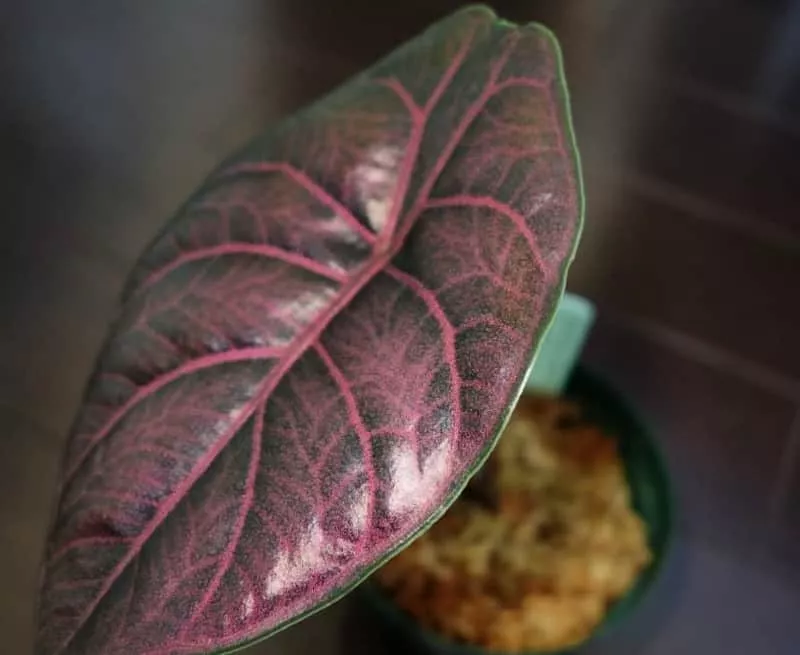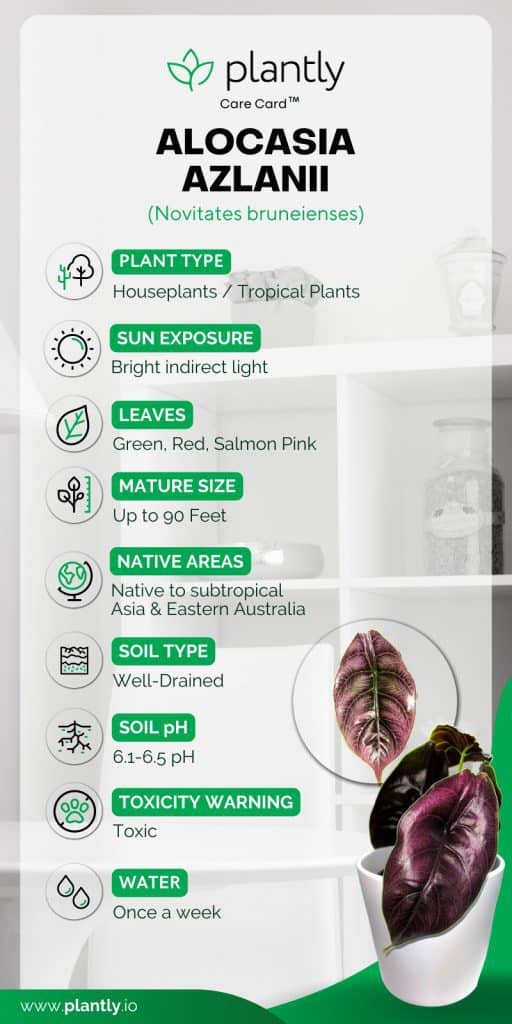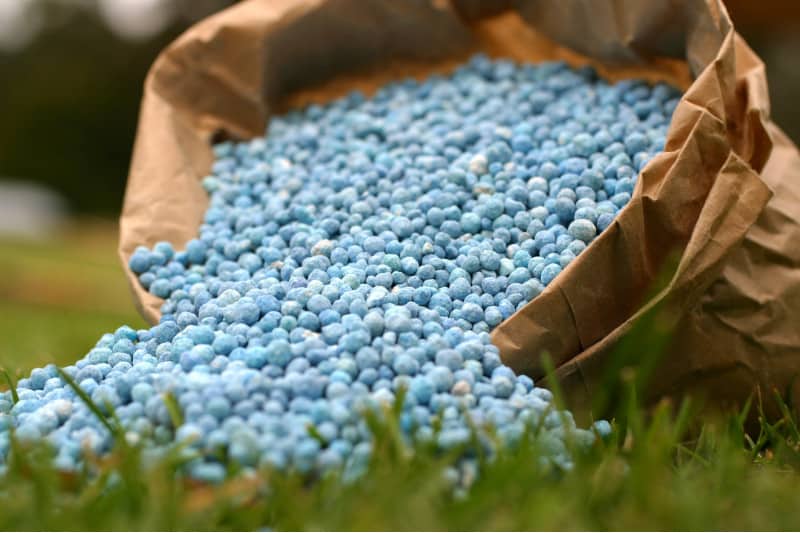No products in the cart.
Table of Contents
Did you know that Alocasia azlanii is one of the world’s most desired houseplants? And because you’re here, maybe you’re one of them too.

Well, you are not in the wrong place! Let me tell you about this beauty’s appearance. The Alocasia azlanii have green leaves with purple, dark red, or black veins colors. The new leaves of this houseplant unfurl slowly. The leaves will turn waxy, deep iridescent green with dark purple or red veins, purple backside, and bright green outlines as they mature. And I know you’ll be love at first sight at this beauty.
And wait, there’s more to this rare houseplant. Azlanii is one of the 97 known Alocasia species around the world! This occasional houseplant has been unknown to the industry because it was one of the recently cultivated houseplants. But who knows? Maybe you’ll be the new owner of it. Find out how to take care of this plant and where you can buy it. Enjoy!
Alocasia Azlanii Plant Care Basics
I know you’re excited to learn how to take care of your Azlanii properly, but let’s first see the plant’s overview. We’ve provided a table down below:

Now that you’ve met and get to know the plant’s overview, we never stop here. Yes, we also want you to know the tips, do’s, and don’ts of efficiently taking care of your Azlanii. Read down below.
Soil Condition
The plant prefers a well-draining, aerated potting soil that can retain some water. The plant’s roots need oxygen to keep them healthy. Mix two parts perlite potting mix with one part coconut husk to make potting soil, and you’re good to go. Always keep an eye on the soil’s moisture level. Make sure to maintain the dampness of the soil because Azlanii’s do not prefer parched soil.
Watering Needs
Just like any other plant, Alocasia azalanii requires water, too; they love water. However! Water your Azlanii sufficiently but not overwatering it to avoid root rot. And we don’t want our plants to suffer. So, check the soil twice a week, and if the top few inches of the soil feels dry, the plant needs to be watered. The pot should have drainage holes so that the excess water will drain quickly and prevent root rot.
Underwatering, on the other hand, could harm the plant. The leaves will droop and turn yellow. Reduce the amount of water you provide the plant when black or brown spots appear on the leaves. In addition to that, the Jewel alocasia requires less water during winter times because of the plant’s dormancy.
Pro tip: Don’t water the plant if the soil is still wholly wet because the damp soil will not let much oxygen through.
Ideal Lighting

The Alocasia azlanii excels in bright indirect light. However, it can also handle a few hours of the morning sun. You also want to avoid too much direct sunlight because this will damage their magnificent leaves. Just make sure to oversee your plant if you’ll put it outside for some sun in the morning.
Pro tip: If you want to cultivate them indoors under artificial lighting, use a full daylight spectrum LED placed around a foot (30 cm) away from it for 14 hours a day.
Temperature & Humidity

The Jewel Alocasia is a tropical plant ideally grown in 65 to 75 degrees Fahrenheit (18 to 24 degrees Celsius). Although Alocasia Azlanii can survive temperature changes, it dislikes being exposed to cold air. This may put your plant under stress, making it more susceptible to diseases and pests.
The Alocasia azlanii plant ideally grows in a higher humidity climate. In about 60%, and higher humidity level. Keeping the Alocasia in low-humidity levels will stun the growth or cause stress on the plant.
Brown patches and brown leaves sometimes edges indicate low humidity. If this happens, use an automatic mister or sprinkle the leaves two or three times with a spray bottle filled with water to add moisture.
Fertilizer Needs
Fertilizing your plant replenishes the critical nutrients that are depleted in the soil. And this Alocasia is a heavy feeder, so feed once a month in the spring and summer, when the plant requires nutrients.

When using fertilizer, be careful not to overdo it, as some beginners do. Over-fertilizing can cause the plant to burn. Use a 1/2 diluted balanced fertilizer to guarantee that the fertilizer does not burn your plant.
Propagation
Since this Alocasia azlanii costs a fortune, no need to buy it again and again, just propagate it! And I know a beginner like you will get the hang out of it. It can be done in three different ways: by division, offsets, and seeds. Just choose among these, and if you master one of them, that’s good for you! And there’s more, if you want to see a successful propagated Azlanii, propagate them in their growing seasons (spring and summer).
Here’s how:
Division
- Remove the plant and brush off the soil from around the roots carefully.
- Using a sharp knife, split the rhizome. Make sure both parts have a good amount of roots. That’s our key to success, so don’t forget about it.
- Plant the split plant in a well-draining soil mix in a pot with drainage holes.
- In a few weeks, the roots will sprout if you continue to care for the plant as you did for your other Azlanii’s
Offsets
- Using clean pruning shears or sharp knives, cut the roots that are linked to the parent plant.
- Carefully pull the young plant away from the mother plant. And then re-pot the tiny plant into a smaller container.
Pro tip: Do not chop away the offsets as they start to appear. Remove the offsets from the mother plant when they reach a height of 7.5 cm. If the baby is larger, propagation of the Alocasia azlanii will be more successful.
Seeds
- Soak the seeds in distilled water overnight. Sow it in a potting soil that drains properly. Best do this process in the Fall season.
- Plant the seeds 1 cm deep in the soil. To maintain a steady, high humidity level, lightly water the seeds and cover the containers with a plastic bag.
- Place the container in bright indirect sunlight. Make sure the soil is kept moist at all times.
- To keep the seedlings warm, place a heat mat under the containers. The success rate of germination is increased when the temperature is warm.
- When the seedlings reach a height of 5 cm, carefully transplant them into larger pots without injuring the roots.
Growth Zone
The Azlanii is fully hardy in USDA zones 7-11.
Potting
The pot of the plant should have a good drainage hole for the excess water to drain quickly. Re-pot the Azlanii every two years to encourage new growth. When repotting, relocate it to another pot whose pot size is slightly bigger than the former.
Alocasia Azlanii Varieties and Similar Plants
There are approximately 97 species of Alocasia plants. If you want to add more just like this Azlanii, we’ve narrowed them down below:
- Alocasia Amazonica

The Amazonica is a hybrid between Alocasia longiloba and Alocasia sanderiana. It is one of the most popular and exotic houseplants.
- Zebrina

The foliage of Zebrina is shield or arrow-shaped, but it lacks white veins. It has stilt-like stalks with zebra print patterning in black and yellow.
- Melo

Alocasia rugosa is another name for this outdoor plant. Large, thick green leaves with a rough texture and pronounced deep veins distinguish it. The plant is stubby and works well in small containers.
Alocasia Azlanii Diseases & Common Pests
Alocasia plants are also vulnerable to different kinds of pests. Some of which are spider mites, mealybugs, scales, and aphids. However, spider mites are known to infest this plant more.
Every few weeks, sprinkle the plant with warm soapy water to keep pests away and maintain it dust-free. Use ultra-fine insecticide oil or neem oil if an infestation occurs. These treatments will kill the pests and their eggs.
Frequently Asked Questions
When you’re repotting or transferring your Alocasia to water, you might find these round-shaped bulbs in the soil. Sometimes they’re attached to the plant’s roots; sometimes, they’re just rolling around in the soil doing their thing (which is sleeping or being dead, basically)
Alocasia Azlanii, or Red Mambo, is the rarest and most beautiful of the Jewel Alocasias.
The Alocasia Azlanii is native to Malaysia, and despite the demand, its in short supply.
Don’t look somewhere to buy this magnificent plant; you can buy it here at Plantly! Yes! Although it’s rare, we guarantee that you will surely get this without any damage. We also offer a reliable and fast transaction process. Message us now!
Whether you want to buy, sell or simply reach out to other plant enthusiasts, Plantly is the right place to be!


